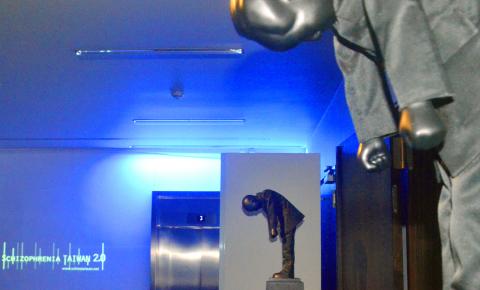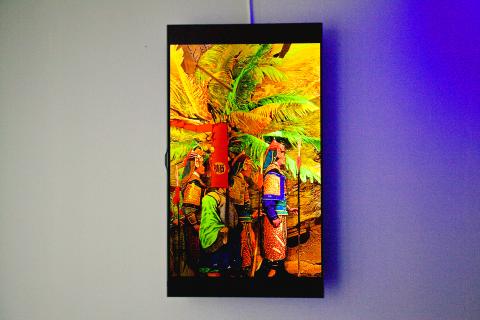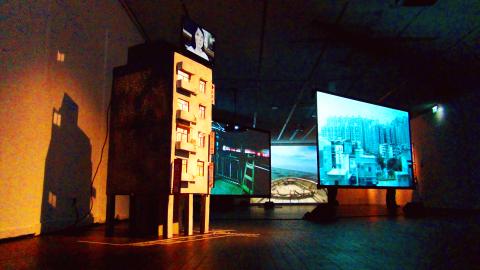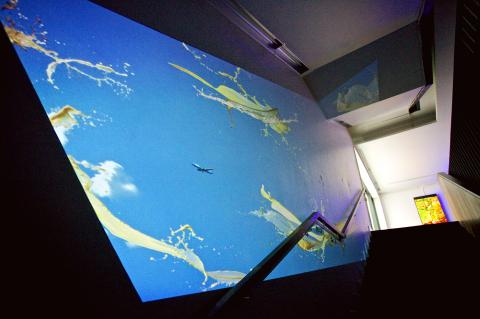A cold, biting Berlin wind is gnawing at every exposed surface of the city and inside the Collegium Hungaricum, a group of Taiwanese artists are huddled in a corner. “So cold,” says a voice from the middle of the pack.
Inquisitive gallery-goers are meanwhile soaking up the group’s sizable collection of art which makes up the globe-trotting exhibition Schizophrenia — Taiwan 2.0.
The event, financed in part by Taiwan’s Ministry of Culture, is an artistic exploration of the country which is described as being caught between two worlds.

Photo: sam sky wild and courtesy of Side by Side Studio
“A condensed symbol of world history, a powerhouse for the global digital economy and its ambivalent national status. Part of the world and at the same time apart from it … The conflict between Taiwan’s strong sense of national identity and its ambivalent national status in relation to China charges daily life with a tension best described as ‘Taiwan’s schizophrenia,’” says the press blurb.
The work on display by 14 artists and includes a mix of visual projections, installations and clockwork sculptures, is as much personal as it is political. Chen Yi-ya’s (陳逸雅) Dear President offers audiences the opportunity to view Taiwan’s struggle for international recognition through a collection of letters from heads of state around the world. Chen, 24, says she had wanted to note which political leaders would address the country directly as Taiwan and how heartfelt the letters were.
“Searching for one’s own national identity by obtaining autographs from heads of state can be read as a gesture for external recognition,” she says.

Photo: sam sky wild and courtesy of Side by Side Studio
Chen, who had requested a direct response and photograph, notes that Belgian Prime Minister Elio Di Rupo signed the letter himself and provided a “simple, clear and approachable” black and white portrait while noting that South African President Jacob Zuma’s giant photoshot indicated that “he must be very proud of himself.”
Nearby, at the entrance to the main exhibition space two black, meter-high mechanical dolls of Mao Zedong (毛澤東) and Chiang Kai-shek (蔣介石) hang limply on either side. Artist Chiu Chao-tsai (邱昭財) says that his collection of wind-up, clockwork icons, which includes the McDonalds logo and a two-meter high AK-47 machine gun, are designed to parody symbols of power.
“They are icons yet they are also rendered powerless like this — they are only given stature once they are powered up by a visitor,” explains Chiu.

Photo: sam sky wild and courtesy of Side by Side Studio
While all the work on display has a potent political critique at its core, not all of it looks at Taiwan within an international context. Rental increases and the economic pressures brought to bear on the so-called “Strawberry Generation” within Taiwan itself informs the work of Chang Li-ren (張立人) — one of the 14 artists whose work is on display — which explores the increasing rich-poor disparity in Taiwan, and Taipei in particular.
“Rent is very high in Taiwan,” says the Taipei-based artist whose incredibly elaborate piece includes a hand-made 1.5 meter-tall Taipei apartment block, complete with tiny air-con units, security grills and lived-in stains. The model was the setting for a montage animation in which the army is seen running amok in the capital.
“Rich people buy more houses for investment, but most people cannot afford a house. These are two different worlds. When people are trapped in this society, it’s like being trapped in a tiny apartment … Everything seems like it is in vain.”

Photo: sam sky wild and courtesy of Side by Side Studio
Tu Pei-shih’s (杜珮詩) colorful yet disturbing work starts off with the depiction of a beautiful, tranquil Taiwanese village scene but ends with a horrific interpretation of the 228 massacre and the mass rape and murder that followed during the White Terror. For Tu it is necessary to tell of Taiwan’s troubled past in order to shape a more optimistic future.
Tu, whose arts-orientated films have been selected for film festivals worldwide, says that “as artists we are all struggling” financially. Tu says that she sells certified, limited edition, copies of her politically-charged work The Adventures in Mount Yu V to buyers from around the world for inclusion in private collections — and at libraries. Even then she says it is “tough” in today’s economic climate.
Organizer Lee Yi-wei (李怡衛) is now in discussions to host the exhibition in both the US and Brazil given the success of the roving art show. Berlin was the third stop in a series which included Linz in Austria and St. Petersburg in Russia.
“St. Petersburg was a highlight and new media is genuinely new there, people really enjoyed it,” says Lee. Housed in the city’s stunning Hermitage Museum the exhibition attracted large numbers and Lee recalls seeing couples on romantic dates watching the videos for hours, arm in arm.
For Lee, a Taipei-native, there is something romantic about Berlin that has prompted the financier-turned-curator, to stay in the city.
“A lot of miracles happened in Berlin for me … I felt like I couldn’t just walk away from this magic — I realized it was meant be”.
The exhibition in Berlin is now closed, but is set to go on display in London, UK in October followed by Marseilles, France in November. More information in English, Chinese, Russian, French and German can be found at: www.schizotaiwan.net.

The canonical shot of an East Asian city is a night skyline studded with towering apartment and office buildings, bright with neon and plastic signage, a landscape of energy and modernity. Another classic image is the same city seen from above, in which identical apartment towers march across the city, spilling out over nearby geography, like stylized soldiers colonizing new territory in a board game. Densely populated dynamic conurbations of money, technological innovation and convenience, it is hard to see the cities of East Asia as what they truly are: necropolises. Why is this? The East Asian development model, with

June 16 to June 22 The following flyer appeared on the streets of Hsinchu on June 12, 1895: “Taipei has already fallen to the Japanese barbarians, who have brought great misery to our land and people. We heard that the Japanese occupiers will tax our gardens, our houses, our bodies, and even our chickens, dogs, cows and pigs. They wear their hair wild, carve their teeth, tattoo their foreheads, wear strange clothes and speak a strange language. How can we be ruled by such people?” Posted by civilian militia leader Wu Tang-hsing (吳湯興), it was a call to arms to retake

This is a deeply unsettling period in Taiwan. Uncertainties are everywhere while everyone waits for a small army of other shoes to drop on nearly every front. During challenging times, interesting political changes can happen, yet all three major political parties are beset with scandals, strife and self-inflicted wounds. As the ruling party, the Democratic Progressive Party (DPP) is held accountable for not only the challenges to the party, but also the nation. Taiwan is geopolitically and economically under threat. Domestically, the administration is under siege by the opposition-controlled legislature and growing discontent with what opponents characterize as arrogant, autocratic

When Lisa, 20, laces into her ultra-high heels for her shift at a strip club in Ukraine’s Kharkiv, she knows that aside from dancing, she will have to comfort traumatized soldiers. Since Russia’s 2022 invasion, exhausted troops are the main clientele of the Flash Dancers club in the center of the northeastern city, just 20 kilometers from Russian forces. For some customers, it provides an “escape” from the war, said Valerya Zavatska — a 25-year-old law graduate who runs the club with her mother, an ex-dancer. But many are not there just for the show. They “want to talk about what hurts,” she